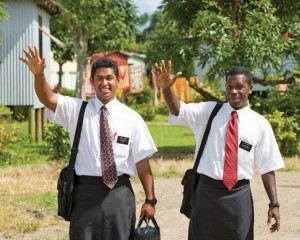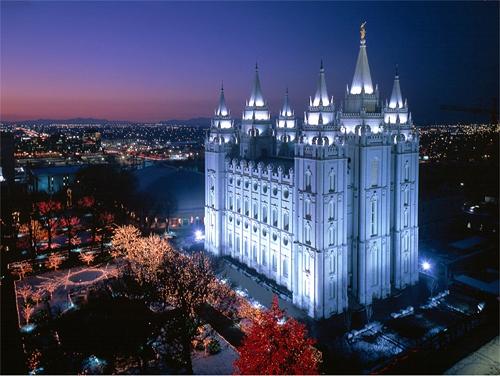The history of Mormon missionary work is almost as long as Mormon history itself, for without missionary work, there would be no Mormon Church. Mormon missionaries have, from the very earliest days of Mormonism, gone out to their neighbors, surrounding communities, and far away lands to preach the Restored Gospel of Jesus Christ. No other church has in modern times undertaken such extensive and sustained missionary activities as has the Mormon Church. Even in the darkest days of persecution, when their leaders were imprisoned and their families driven and scattered by mobs and armies, Mormon missionaries have continued to go forth, two by two, to fulfill God’s charge to preach the gospel to every person, baptizing in the name of the Father, the Son, and the Holy Ghost.
 The revelation, given through the Prophet Joseph Smith to his father reads in part:
The revelation, given through the Prophet Joseph Smith to his father reads in part:
“Now behold, a marvelous work is about to come forth among the children of men. Therefore, O ye that embark in the service of God, see that ye serve him with all your heart, might, mind and strength, that ye may stand blameless before God at the last day … For behold the field is white already to harvest; and lo, he that thrusteth in his sickle with his might, the same layeth up in store that he perisheth not, but bringeth salvation to his soul” (Doctrine and Covenants 4:1-2,4).
This revelation has become a call to all Mormon missionaries to remind them whom they serve and how they serve. Today, more than 55,000 Mormon missionaries are preaching the restored gospel at any one moment. The history of Mormon missionaries, though much too large a subject to address succinctly here, is one of faith and sacrifice, demonstrating the power of Mormon beliefs to inspire the faithful to share their message with the world.
Periods:
Mormon missionaries and the Prophet Joseph Smith first preached the message of the Restored Gospel of Jesus Christ throughout the Eastern United States and Canada. Official missionary work did not begin until the Book of Mormon was published in March of 1830. The first official Mormon missionaries left in April and in the Fall of 1830, four Mormon missionaries departed to preach to the Indians, but instead baptized hundreds in Ohio. The Mormon Church was organized, and persecution drove its members to gather in Ohio.
The Mormons gathered to Ohio and began to build the first Mormon temple in Kirtland, while other Mormons gathered in western Missouri. For the first time Missions were organized with presidents, and organized missionary efforts were designed to ensure that every person would eventually hear the message. The Quorum of the Twelve Apostles was organized, and they served missions throughout the United States, and as the first Mormon missionaries in England.
Mormon Missionaries in Foreign Lands
By the 1840s Mormon missionaries were preaching throughout Europe and North America, and some even reached the Middle East. Others began to proselyte in the Pacific Islands. The Book of Mormon was translated into new languages, but most Mormons converted in foreign lands soon emigrated to the United States, both to gather with the other Mormons and to flee persecution in their native lands. The Mormons moved to Utah, and despite fierce persecution, they sent thousands of missionaries into new lands in Asia, the South Pacific, and especially into Mexico and South America.
As official persecution ended, Mormons expanded their missionary efforts into Japan, Lebanon, and especially throughout South America, where the Mormon Church began to grow very quickly. For the first time, Mormon missionaries received training beginning in the 1920s as some, but not all, Mormon missionaries reported to the Mission Home in Salt Lake City for a few weeks before leaving. Mormonism grew especially in Europe during this period.
After World War II and the Korean War, Mormon missionaries found great success in Korea, Japan, and the Philippines. Mormonism began its explosive growth in South America and temples were built throughout the world. Mormon missionary efforts became even more organized as the Language Training Mission and later the Missionary Training Center were built in Provo, Utah. President David O. McKay stepped up calls for more missionaries and for every member of the Mormon Church to do missionary work. He traveled the earth and sent missionaries into new lands.
The Nations of the World Open up to Mormon Missionaries
 Beginning in the 1970s Mormonism saw its most rapid growth, especially in South America and Africa following the 1978 revelation on the Priesthood received by President Spencer W. Kimball. The Book of Mormon was translated into dozens of more languages in the 1970s and 1980s, and Mormons were encouraged to “flood the earth” with it in order to find all those who will join. President Kimball also received a revelation commanding all young men to serve as Mormon missionaries, and by the 1980s there were over 50,000 Mormon missionarie serving at any one time. Countries in Africa and South America began to open up to the Mormons, but the real miracle came as the Soviet Union collapsed in the early 1990s, and Mormon missionaries moved into Eastern Europe, Russia, and Central Asia.
Beginning in the 1970s Mormonism saw its most rapid growth, especially in South America and Africa following the 1978 revelation on the Priesthood received by President Spencer W. Kimball. The Book of Mormon was translated into dozens of more languages in the 1970s and 1980s, and Mormons were encouraged to “flood the earth” with it in order to find all those who will join. President Kimball also received a revelation commanding all young men to serve as Mormon missionaries, and by the 1980s there were over 50,000 Mormon missionarie serving at any one time. Countries in Africa and South America began to open up to the Mormons, but the real miracle came as the Soviet Union collapsed in the early 1990s, and Mormon missionaries moved into Eastern Europe, Russia, and Central Asia.
Today, the focus of missionary work has been to consolidate the massive growth of the past few decades with President Gordon B. Hinckley’s call to help every convert find a friend, a responsibility, and nourishment by the word of God. Requirements to become a missionary are tightened and while the number of missionaries drops slightly, retentions rates among converts rises. Temples are built throughout the earth to bring the temples to the members of the Church. More Missionary Training Centers are built on nearly every continent to help all Mormon missionaries prepare spiritually and physically for their missionary service. President Hinckley’s vision is carried on by President Thomas S. Monson.
Twitter •

 Watch a video about the restoration of the gospel on lds.org
Watch a video about the restoration of the gospel on lds.org
Denis,
I’m glad you’re contributing to the Wiki (and you may want to do the same for our MormonWiki, without duplicating what you’ve already done)! You may want to visit the official site, lds.org and submit a question there, since I am not familiar with official statements about that particular calling. They should be able to direct you. Let us know if you’ve further questions. Please become a friend of the foundation by signing in at our portal at http://www.moregoodfoundation.org. All the best.